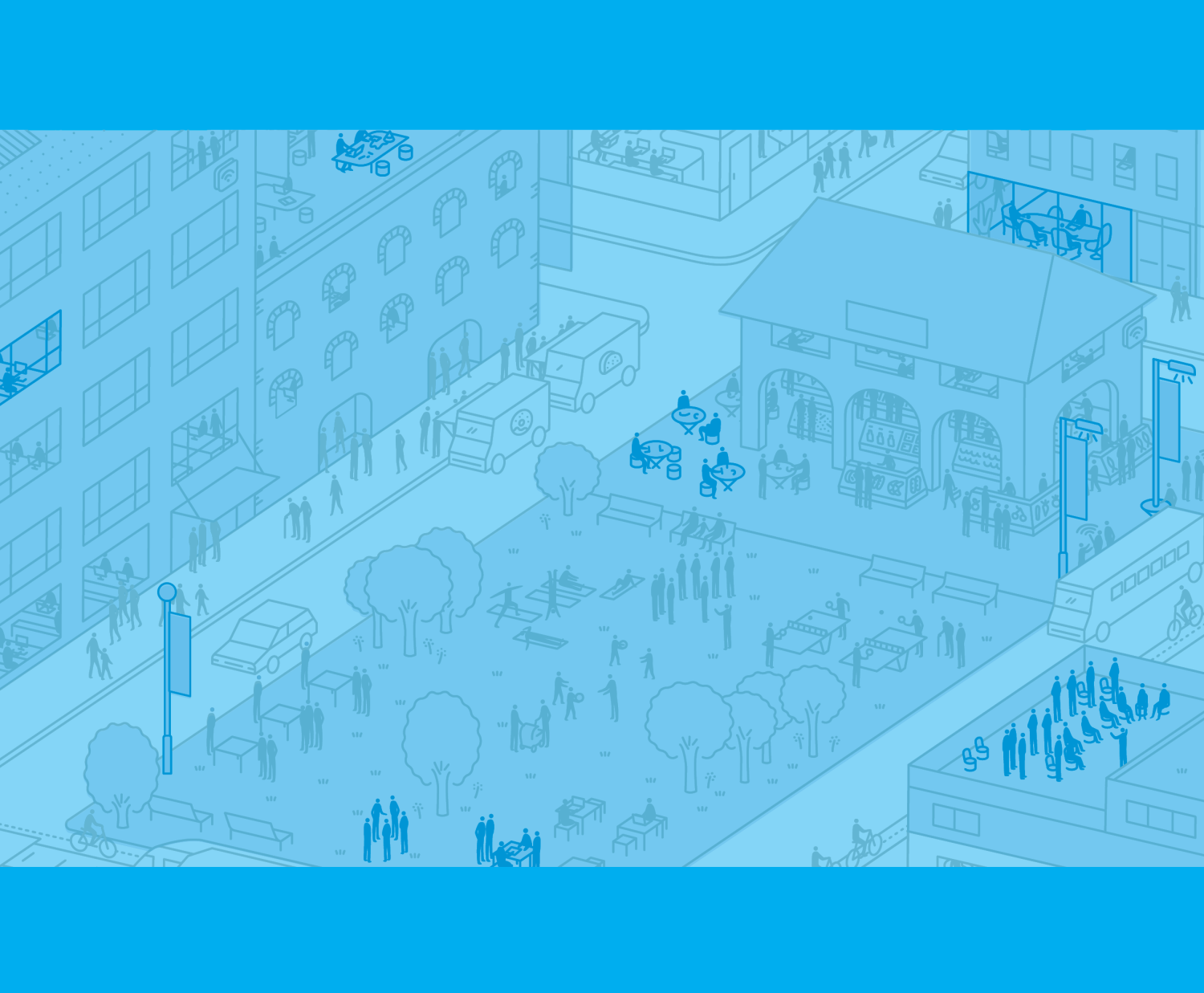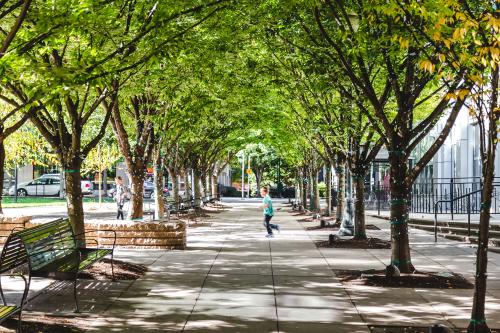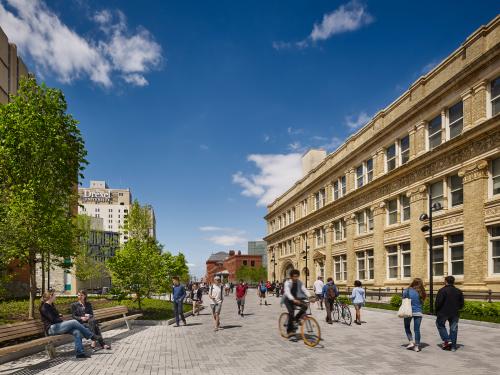Click here to read the other Opportunities for Transformative Placemaking case studies.
The past 15 years have witnessed a rise in the growth of urban innovation districts—mixed-use, walkable, and transit-rich urban areas where anchor institutions and mature companies cluster with start-ups, business incubators, and accelerators. While drivers of job growth and revitalization, these districts also tend to reflect the knowledge-based industries that comprise them, and thus often lack diversity in terms of workforce, business ownership, and decision-making.
This profile examines the recently designated innovation district in downtown Chattanooga, Tennessee, where stakeholders are undertaking intentional efforts to ensure that low-income and minority residents are key participants in, and beneficiaries of, the area’s growth and development.
History and context
Chattanooga, Tenn. has a long history as a logistics and manufacturing hub, but by the 1980s, the city faced a combination of lingering pollution amid declining industry. The city lost nearly 10 percent of its population throughout the 1960s, and another 10 percent from 1980 to 1990. Dubbed by iconic CBS News anchor Walter Cronkite as “the dirtiest city in America,” the city’s image during this period was poor, and the urban core was depressed—a single-use office district, with few people out on the streets or living downtown.
Today Chattanooga is cleaner, cooler, and experiencing a boom in entrepreneurship. Its population has bounced back to 179,139 and the unemployment rate has dropped from a peak of 9.8 percent in May 2009 to a low of 3.3 percent in May 2018. Over the past several decades, the downtown particularly has become a lively mixed-use district, with residential population increasing 23 percent from 2000 to 2015—nearly double the rate of surrounding Hamilton County—and retail vacancies declining to under 2 percent by 2016.1 Yet now as ever, not everyone shares in this newfound prosperity.
Indeed, perhaps no place best embodies the promise and perils of the new Chattanooga than the Chattanooga Innovation District. In 2015, the city officially designated the district in part of the downtown in hope of taking full advantage of the city’s public high-speed internet infrastructure (known colloquially as “the Gig”). This new district builds on a 30-year history of public-private partnership in development led by the River City Company, which redeveloped the Tennessee River waterfront, built the well-known Tennessee Aquarium, and catalyzed private development throughout the downtown. Unlike many innovation districts, which have major corporations or research universities as their primary anchors, Chattanooga’s energy revolves around EPB, the city’s public electric and telecommunications utility, and the Edney Innovation Center, an 11-story building that combines community programming, business services, co-working and private office spaces. The district’s vision plan focuses on six key values, including innovation, education, culture and history, public life, and treating the district as an urban lab. However, perhaps the most important and difficult to fulfill values in the plan focus on supporting diversity and inclusion—especially along racial lines—while managing the threat of gentrification.
American urban development has been shaped by racist practices in zoning, transportation, education, urban renewal, law enforcement, and private and public housing, often encouraged or dictated at the federal level. Chattanooga is no exception.2 “Redlining” maps, which denied public and private investment in the areas where communities of color lived, affected many neighborhoods in the city, including some directly adjacent to the downtown and innovation district. The legacy of these and other policies have persisted: In 2010, the city’s “dissimilarity index,” a common measure of segregation, was 57.8 out of a possible 100, suggesting a moderately high degree of segregation.3 Educational attainment in Chattanooga also differs significantly by race, with white residents three times as likely to have a bachelor’s degree as black residents, and black residents twice as likely to lack a high school diploma.4 These disparate educational outcomes echo through the city’s income statistics: In 2010, the median income for non-Hispanic white households in Chattanooga was nearly double that of black households, and from 2000 to 2014 incomes grew nearly 17 times faster for white households than black ones.5 While stark, these inequalities are only slightly more acute than in America at large.
Challenges and opportunities
In this context, it is understandable why diversity and inclusion became core values for the city’s innovation district.6 “Chattanooga has benefited from being a late starter,” notes Marcus Shaw, CEO of The Company Lab (Co.Lab), a nonprofit accelerator in the district. When the district was first announced in 2015, Chattanooga leaders decided that they needed a different approach than the country’s biggest high-tech hubs, like San Francisco or Boston, which continue to struggle with affordability and diversity. Accordingly, “intentional” has become the watchword when it comes to equity in Chattanooga, and the mediating organizations responsible for the district have aimed to bake equity into their missions. “The ramp up period is harder when you build diversity in at the beginning,” continues Shaw. “More friction, but less risk in the long run—just like a portfolio.”
Co.Lab provides one example of how this intentional approach plays out in practice. In their annual report, they track the growth of minority and women-owned business ownership as one of their key outcomes. At a glance, Co.Lab’s success in this regard appears limited at first, with the percentage of female and minority program participants since 2010 hovering close to the proportions for the county as a whole. But the trend line is positive. The 2016 cohort was 64 percent women founders, and 31 percent minority founders—23 percent and 14 percent higher than countywide numbers, respectively. Integral to this shift has been Co.Lab’s partnership with LAUNCH Chattanooga, another nonprofit with a tight focus on supporting individuals and communities that are underrepresented in the city’s entrepreneurial ecosystem. Marco Perez, vice president of operations for LAUNCH, describes the approach of many incubators and accelerators as identifying and supporting a handful of “home-run hitters.” LAUNCH, on the other hand, is a “teach everyone to bat” organization, open to neighborhood micro-businesses as much as to prospective fast-growing companies with regional significance. While their programs make an enormous difference in the lives of individuals and households, this is also a slow process that requires patience and a long-term investment in relationships.
Place plays a crucial and multifaceted role in all of these initiatives. “Density is important,” says Shaw. “It’s a fact of physics. Density creates power. Density creates opportunities to have force and to combine.” In practice, this means that most of the people Shaw needs to get something done are his neighbors. “When I need to meet somebody, I literally walk. Every influencer in this city I can walk to.” The same benefits of concentration extend to the participants as well as the leaders of these programs. They, too, gain access to the social networks, entrepreneurial culture, and resources of the innovation district through placemaking in public spaces, like the recently renovated Miller Park and community spaces like the Edney Innovation Center.
Even Chattanooga’s citywide digital equity initiatives emphasize the centrality of the district. Tech Goes Home Chattanooga helps connect residents to the city’s ultra-high-speed internet through a combination of subsidized hardware and internet access, as well as digital literacy training. Sammy Lowdermilk, program manager of Tech Goes Home, observes that many people outside the downtown area are not familiar with the innovation district. “This innovation district concept is relatively new. A lot of the community doesn’t really understand it. Tech Goes Home is a good conduit to help individuals understand what positive impact the innovation district could have on the city.” Regular events hosted by Tech Goes Home are often participants’ first introduction to the Edney building, but as familiarity and a sense of ownership have grown, Lowdermilk has noticed an uptick in organizations outside the innovation district taking advantage of these resources.
Nevertheless, the innovation district approach also has its pitfalls. In particular, a 2018 report found that Census Tract 31, which includes the innovation district, experienced significant change by income and racial composition between 2000 and 2015. In that time, the area saw a sevenfold increase in the number of households earning over $75,000, a 16 percent decline in the number of households making less than $20,000, and a 25 percent decline in the number of black households.7 The question the authors of the report raise is an ethically challenging one: To what extent do concerns about localized gentrification distract from the potential of inclusive citywide economic growth? This question is especially hard to answer when the district is so young, and the upsides so uncertain. While individual programs like Co.Lab, LAUNCH, and Tech Goes Home show promising results for their participants, the scale of poverty and inequality in Chattanooga and other American cities is vast. Can the complex ripple effect of creating more diverse entrepreneurship, decision-making, and ownership be great enough to reach all Chattanoogans?
“Everyone around the country is trying to figure out how this works,” concludes LAUNCH’s Perez. “Chattanooga has a long ways to go with regards to equity, but I think we’re the city that can actually figure out how to do it right.”
-
Footnotes
- Christopher Leinberger and Tracy Haddon Loh, “Catalytic development: (Re)creating walkable urban places” (Washington: Brookings, 2018), available at https://www.brookings.edu/research/catalytic-development-recreating-walkable-urban-places/.
- Richard Rothstein, The Color of Law. (New York: Liveright, 2017).
- Joan McLane, “Fifty years after the Fair Housing Act, neighborhoods in Chattanooga are still segregated,” Chattanooga Times Free Press, February 25, 2018; available at https://www.timesfreepress.com/news/local/story/2018/feb/25/fifty-years-after-fair-housing-act-neighborho/464531/.
- StatisticalAtlas.com; available at https://statisticalatlas.com/place/Tennessee/Chattanooga/Educational-Attainment.
- StatisticalAtlas.com; available at https://statisticalatlas.com/place/Tennessee/Chattanooga/Household-Income#figure/median-household-income-by-race.
- Innovation District of Chattanooga Framework Plan, available at https://framework.chainnovate.com/values/.
- Arnault Morrison and Carmelina Bevilacqua, “Balancing gentrification in the knowledge economy: the case of Chattanooga’s innovation district,” Urban Research and Practice (May 16, 2018); available at https://www.tandfonline.com/doi/abs/10.1080/17535069.2018.1472799. Note that households with incomes below $10,000 remained constant due primarily to the presence of Patten Towers, a housing development for the elderly.






